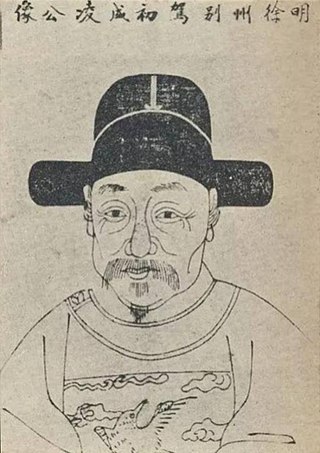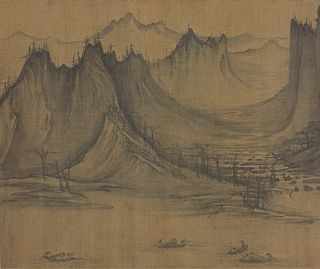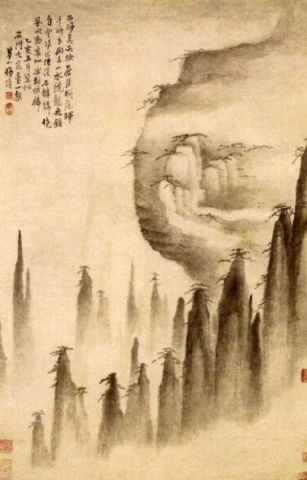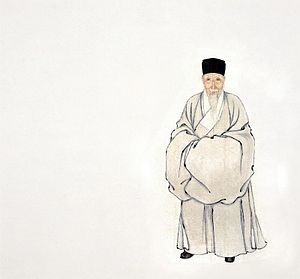
Mei Yaochen (1002–1060) was a Chinese poet of the Song dynasty. He was one of the pioneers of the "new subjective" style of poetry which characterized Song poetry.

Wen Tong (1019–1079) was a Northern Song painter born in Sichuan famous for his ink bamboo paintings. He was one of the paragons of "scholar's painting", which idealised spontaneity and painting without financial reward.

Qian Qianyi was a Chinese historian, poet, and politician during the late Ming dynasty. Qian was a famous author and poet; and along with Gong Dingzi and Wu Weiye was known as one of the Three Masters of Jiangdong.

Qiu Ying was a Chinese painter of the Ming dynasty who specialised in the gongbi brush technique.

Ling Mengchu was a Chinese writer of the Ming Dynasty. He is best known for his vernacular short fiction collections Slapping the Table in Amazement (拍案驚奇), I and II.

Huáng Bīnhóng was a Chinese literati painter and art historian born in Jinhua, Zhejiang province. His ancestral home was She County, Anhui province. He was the grandson of artist Huang Fengliu. He would later be associated with Shanghai and finally Hangzhou. He is considered one of the last innovators in the literati style of painting and is noted for his freehand landscapes.
Jiao Bingzhen was a native of Jining, Shandong who became a noted painter and astronomer. He is one of the first Qing dynasty painters to blend traditional Chinese painting with western culture. He is also among the more significant portrait and miniature painters in the early Qing. He was skilled in painting people, landscapes, and buildings.

Qian Xuan, courtesy name Shun Ju (舜举), pseudonyms Yu Tan, Xi Lanweng (习嬾翁), and Zha Chuanweng (霅川翁), was a Chinese painter from Huzhou (湖州), the present day Wuxing District in Zhejiang. He lived during the late Song dynasty and early Yuan dynasty.

Chen Hongshou, formerly romanized as Ch'en Hung-shou, was a Chinese painter of the late Ming dynasty.

Xu Daoning was a Chinese painter of the Northern Song Dynasty (960–1279) from Chang'an or Hejian. He started out life by selling medicine prescriptions in Kaifeng. While selling prescriptions, he also began painting nature scenes in the style of Li Cheng. After gaining popularity he took up painting murals for Chinese nobles. His most notable work is Fishermen's Evening Song.
Xiao Yuncong was a famed Chinese landscape painter, calligrapher, and poet during the late Ming and early Qing dynasties.
Cao Buxing was a painter of the state of Eastern Wu during the Three Kingdoms period of Chinese history. He lived in Wuxing. His name is sometimes written as Cao Fuxing (曹弗興). He excelled in painting dragons, tigers and human figures.

Ju Chao, a native of Panyu (番禺), now Guangzhou, was a famed Chinese painter in the Qing dynasty. His courtesy name was Meisheng (梅生), and pseudonym Meichao (梅巢) or Guquan. He was the older brother of the painter Ju Lian. He wrote "Poems of Shouxie Shi" (首邪室诗) and "Yanyu Ci" (烟语词).

Ma Wan was a Chinese landscape painter, calligrapher, and poet during the Yuan Dynasty (1271–1368). His specific dates of birth and death are not known.

Wang Yi ; ca. (1333-unknown) was a Chinese painter of human figures during the Yuan Dynasty (1271–1368). His specific date of death is unknown.

Wang Zhenpeng ; was a Chinese landscape painter who worked in the imperial court during the Yuan Dynasty (1271–1368). His specific dates of birth and death are not known, though he was active 1280–1329.

Mei Qing was a Chinese landscape painter, calligrapher and poet active during the Qing Dynasty.

Ju Lian, a native of Panyu (番禺, now Guangzhou, was a Chinese painter in Qing Dynasty. His courtesy name was 'Ancient Spring', and self-given pseudonym 'Old Man of the Divided Mountain'. He was the younger brother of the painter Ju Chao. He was known for his bird-and-flower paintings as well as people and plant-and-insect paintings. He was the teacher of the brothers Gao Jianfu and Gao Qifeng.
Li Rihua (1565–1635) was a Chinese bureaucrat, artist and art critic from Jiaxing, during the late Ming Dynasty. He wrote an extensive diary, the Weishuixuan riji, from 1609 to 1616, which detailed his many acquisitions as an art collector. The diary is so named because Li had a reputation as a connoisseur of tea, and was particularly skilled at selecting the best water with which to brew it. He made inscriptions on several paintings of courtesan Xue Susu. In the autumn of 1612, Li Rihua's disciples brought him a statue of Guanyin hand-embroidered by Xue Susu and a volume of "Prajna Heart Sutra", which Li Rihua rated as "extremely exquisite".
In Chinese literature, xiaopin is a form of short essay, usually non-fictional, and usually being exclusively composed in prose. The form is comparable to that of Tsurezuregusa by the Japanese monk Yoshida Kenkō. The genre flourished in the late Ming and early Qing dynasties.















